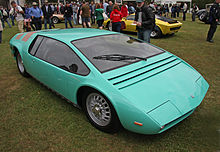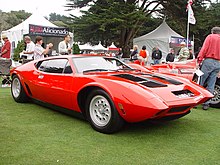
Gruppo Bertone, commonly known as Bertone, was an Italian industrial design company which specialized in car styling, coachbuilding and manufacturing. It formerly was also a car manufacturing company. Bertone styled cars for Abarth, Alfa Romeo, Aston Martin, BMW, Citroën, Ferrari, FIAT, Iso, Lancia, Lamborghini, Mercedes-Benz, Opel, and Volvo, among others. In addition, the Bertone studio was responsible for two of the later designs of the Lambretta motorscooter.

ASA was an Italian automobile manufacturer active from 1961 to 1969, who is known for manufacturing the ASA 1000 GT. This car was developed by Ferrari engineers in the late 1950s as a less expensive, compact alternative to existing Ferrari GT cars. ASA used inline-four and straight-six engines derived from the "250" 3-litre V12 designed by Gioacchino Colombo. The chassis was developed by Giotto Bizzarrini and was derived from the tubular frame chassis of the 250 GTO.

The Ferrari 250 GTO is a grand tourer produced by Ferrari from 1962 to 1964 for homologation into the FIA's Group 3 Grand Touring Car category. It was powered by Ferrari's Tipo 168/62 Colombo V12 engine. The "250" in its name denotes the displacement in cubic centimeters of each of its cylinders; "GTO" stands for Gran Turismo Omologato, Italian for "Grand Touring Homologated".

The Ferrari 250 is a series of sports cars and grand tourers built by Ferrari from 1952 to 1964. The company's most successful early line, the 250 series includes many variants designed for road use or sports car racing. 250 series cars are characterized by their use of a 3.0 L (2,953 cc) Colombo V12 engine designed by Gioacchino Colombo. They were replaced by the 275 and 330 series cars.
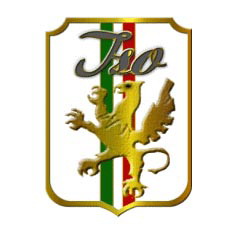
ISO Rivolta is an Italian car and motorbike manufacturer active in the motor vehicle sector since 1938. Over the years, the company has taken various names, including Isothermos, Iso Autoveicoli Spa in 1952, Iso Rivolta in 1962, Iso Motors in 1973 and, in 2017, a return to ISO Rivolta.
The Ferrari P was a series of Italian sports prototype racing cars produced by Ferrari during the 1960s and early 1970s.
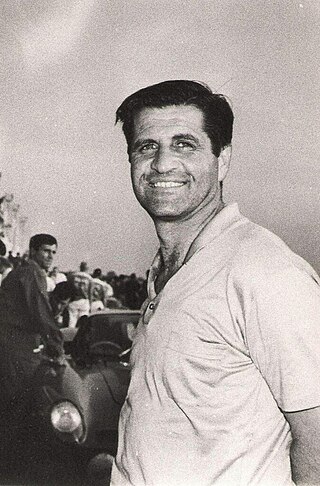
Giotto Bizzarrini was an Italian automobile engineer who was active from the 1950s through the 1970s.

The Bizzarrini Strada, is a sports car produced by Bizzarrini from 1964 to 1968. Sold as an exceptionally low slung, two-seat coupé, roadster, and track-tuned "Corsa" racer, it proved to be Bizzarrini's most successful model.

The P538 or P538S was a rear-engined race car launched in late 1965 or early 1966 by Scuderia Bizzarrini of Livorno, Italy.

Carrozzeria Sports Cars was a small carrozzeria in Modena, Italy, which produced sports and racing car bodies from 1960 until 1971. The company was founded by one-time Formula One driver, Piero Drogo along with coachbuilders Lino Marchesini and Celso Cavalieri. As the public face of the company, Drogo's name became synonymous with the cars produced by C.S.C., which are often referred to as "Drogo" bodies or designs. The workshop constructed bodies for many companies, racing teams and individuals including Scuderia Ferrari, Scuderia Serenissima, Iso and Giotto Bizzarrini. Financial difficulties led to the closure of Carrozzeria Sports Cars in 1971.

The Ferrari 250 GT SWB Breadvan is a one-off Ferrari made in 1962 from a 1961 Ferrari 250 GT Berlinetta SWB, chassis number 2819 GT. It was built to compete against the new 1962 Ferrari 250 GTO at the 24 Hours of Le Mans and other FIA World Sportscar Championship races.

The Iso Grifo is a limited production grand tourer manufactured by Italian automobile manufacturer Iso Autoveicoli S.p.A. between 1965 and 1974. Intended to compete with Grand Touring offerings from Ferrari and Maserati, it used a series of American power trains and components supplied by Chevrolet and Ford. Styling was done by Giorgetto Giugiaro at Bertone, while the mechanicals were the work of Giotto Bizzarrini.

The Iso Rivolta is a grand tourer introduced in 1962 by Italian automobile manufacturer Iso Automotoveicoli S.p.A. Company chairman Renzo Rivolta and his colleague, former Ferrari engineer Giotto Bizzarrini, saw it as a gran turismo in the original sense of the term, designed for long and memorable journeys. It was the first luxury automobile introduced by the company which formerly specialised in affordable motor vehicles. For motor racing, an entirely different variant was made which bore a strong resemblance to the 1962 model Ferrari 250 GT SWB Breadvan and was homologated as a touring car.

Renzo Rivolta was an Italian Engineer.
Neri and Bonacini, also known as Nembo, was a small carrozzeria and mechanic shop based in Modena, Italy, active from the late 1950s to around 1967. Founded and run by Giorgio Neri and Luciano Bonacini, the shop worked on and produced bodies for Ferrari, Lamborghini and Maserati road and race cars, both in an official capacity for those manufacturers and for private owners. Their best known projects are the Ferrari 250 GT-based Nembo spiders and the Lamborghini 400GT Monza. Neri and Bonacini also designed a car under their own name, the Neri and Bonacini Studio GT Due Litri. Two prototypes of this car were made between 1966 and 1968 but it never entered series production. The shop closed around 1967 when Bonacini went to work for De Tomaso and Neri started his own shop, Motors-World-Machines (MWM).
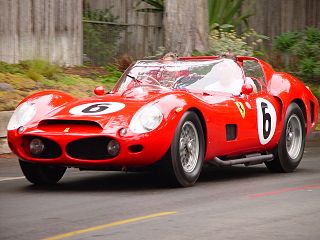
The Ferrari 330 TRI/LM Spyder is a unique racing sports car purpose-built in 1962 by Ferrari to achieve victory at the 24 Hours of Le Mans. It was the last Ferrari racing sports car with a front-mounted engine and the last of a series of Ferrari race cars known as the Testa Rossas. The "I" in its designation indicates that the car has an independent rear suspension.
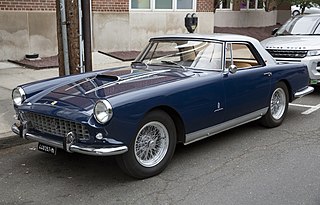
The Ferrari 250 GT Coupé represented a series of road-going, grand touring cars produced by Ferrari between 1954 and 1960. Presented at the 1954 Paris Motor Show, the 250 Europa GT was the first in the GT-lineage. The design by Pinin Farina was seen as a more civilised version of their sporty Berlinetta 250 MM. Series built cars were an answer to the wealthy clientele demands of a sporty and luxurious Ferrari Gran Turismo, that is also easier to use daily.

The Dino 206 S is a sports prototype produced by Ferrari in 1966–1967 under the Dino marque. Ferrari intended to produce at least fifty examples for homologation by the CSI in the Sport 2.0 L Group 4 category. As only 18 were made, the car had to compete in the Prototype 2.0-litre class instead. In spite of this handicap the Dino 206 S took many class wins. The 206 S was the last of the Dino sports racing cars and simultaneously the most produced.

The AMC AMX/3 is a mid-engine sports car from American carmaker American Motors Corporation (AMC), which was presented in March 1970 and was to be produced in Germany by Karmann starting in 1971. With this car, AMC wanted to compete with the similarly designed De Tomaso Pantera that Ford sold in the USA. The car's body and drivetrain were originated and developed by AMC, and Dick Teague styled it. American Motors consulted and partnered with Italian suppliers to develop the chassis and suspension.
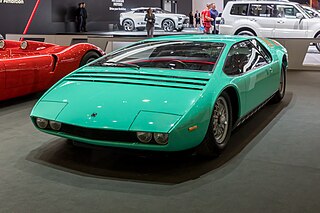
The Bizzarrini Manta is a concept car designed by Italdesign, which was presented to the public in 1968. The body designed by Giorgetto Giugiaro in the so-called one-box style is considered to be groundbreaking for the design of later mid-engine sports cars. According to the manufacturer, the frame and chassis come from a Bizzarrini P538, the engine is a high-volume eight-cylinder Chevrolet.








